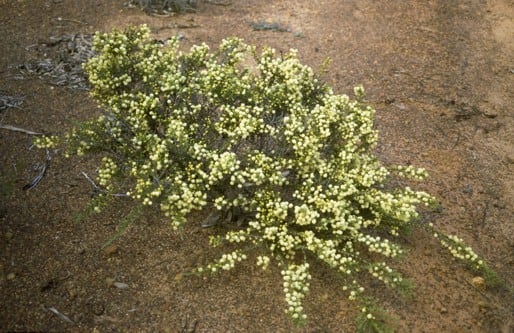Acacia bidentata Benth.
WATTLE
Acacias of Australia
Family
Fabaceae
Distribution
Occurs predominantly from near Winchester S to the Stirling Ra. Natl Park and E to near Grass Patch and Coolinup (c. 50 km E of Esperance); also found in the Kalbarri area, c. 250 km N of Winchester, south-western W.A.
Description
Prostrate or domed shrub to 0.5 (–1) m high. Branchlets scurfy white, pubescent, hirsutellous, appressed-puberulous or subglabrous, not spinose. Stipules caducous or inconspicuous and less than 1 mm long. Phyllodes inequilaterally obovate to obtriangular-obdeltate, with upper margin forming a prominent rounded angle towards apex and lower margin straight to shallowly convex and ending in a distinct short acute point, concave between the angle and point, usually 4–7 mm long and 2.5–5 mm wide, slightly thickened, green, glabrous or hairy on margins; main nerve obscure and near lower margin, sometimes with second nerve from pulvinus. Inflorescences 1–3-headed racemes with axes to 2 mm long; peduncles 3–10 mm long, glabrous or hairy; basal bracts persistent; heads globular to obloid, loosely 10–16-flowered, creamy white or pale yellow. Flowers 5-merous; sepals united; bracteoles not exserted in bud. Pods strongly curved to 1–1 1/2-coiled, to 15 mm long (unexpanded), 3–4 mm wide, thinly crustaceous, glabrous. Seeds longitudinal, oblong-ovate, 3–3.5 mm long; aril oblique.
Habitat
Grows in clay, sand, sandy loam, gravelly loam and loam, in mallee woodland and heath.
Specimens
W.A.: c. 3 km N of Winchester, 28 Aug. 1972, C.Chapman s.n. (PERTH); 24.1 km from Kalbarri Coast road (Grey St) on road towards Ajana, R.S. & R.A.Cowan A-814 (CANB, K, MEL, NSW, NY, PERTH, US); Swan R., J.Drummond 38 (K, MEL, PERTH) and 148 (BM, K, LD, MEL, NSW, OXF, P, PERTH); c. 8 km NE of Ravensthorpe, B.R.Maslin 3927 (K, PERTH); Mt Madden, P.G.Wilson 6764 (CANB, MEL, NSW, NY, PERTH).
Notes
Similar to A. orbifolia which has larger, sinuate-dentate phyllodes, longer peduncles and larger heads with more flowers per head. The few specimens of A. bidentata (including Drummond 38 and 148) with larger than normal phyllodes, i.e. to 10 mm long and 7 mm wide, can be distinguished by the other character states separating the species. The two species appear to hybridise near Watheroo (cf. R.J.Cumming 2122, MELU, PERTH). Specimens of A. ericksoniae and A. improcera were formerly confounded with this species, and broad phyllode forms of A. acanthoclada are superficially similar; all three species are distinguished from A. bidentata by their spinose branchlets and golden flower-heads. Also similar to A. aristulata.
FOA Reference
Data derived from Flora of Australia Volumes 11A (2001), 11B (2001) and 12 (1998), products of ABRS, ©Commonwealth of Australia
Author
B.R.Maslin
This identification key and fact sheets are available as a mobile application:
URL: https://apps.lucidcentral.org/wattle/
© Copyright 2018. All rights reserved.










